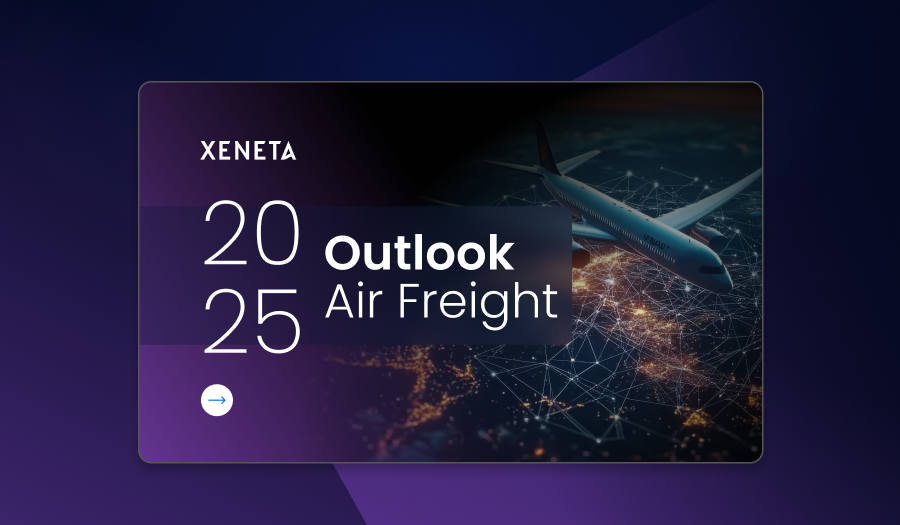It is impossible to downplay the significance of the tariffs imposed by President Trump because they are on a scale never seen before, both in terms of geography and financial severity.
The tariffs will shift global trade on its axis and the impact will be profound and lasting.
The journey to overcome these challenges will be painful, but it must start today. If shippers have the right tools at their disposal and are willing to adopt new approaches to supply chain set ups and freight procurement, perhaps they may be all the stronger for it in the long term.
Key actions and considerations are set out below.
Monitor current trade routes and understand where the market is headed
If you are negotiating ocean container shipping contracts right now, you need to distinguish this from the overall landed cost of importing into the US, which will increase significantly due to the tariffs.
If margins are getting tighter, shippers need to negotiate even harder to reduce supply chain costs and opportunities can be found in the falling ocean container shipping market.
Average spot rates on the Far East fronthauls have fallen 43% and 50% into the US East Coast and US West Coast respectively since 1 January. With the frontloading seen during 2024 now easing, spot rates are likely to continue the downward trajectory.
Carriers will tap into the fear caused by the tariffs to arrest this decline – just as they did on 1 April when spot rates increased 8% into the US East Coast and 14% into the US West Coast. This increase will not last, so shippers must trust the data, shut out the noise, and target the right level of the market for their business needs.

Keep your options open
The dust is yet to settle and the sheer scale of the tariff schedule means it will take some time to fully assess the implications on individual supply chains.
Unfortunately, time is a luxury businesses don’t have because they need to keep goods moving. In these circumstances it’s imperative to keep options open. Whether you are exploring new trade routes, moving volumes between service providers or shifting manufacturing set ups, this will take time and you do not want to lock into a contract today that limits your options down the line.
This means the T&Cs you agree in your next long-term freight contract are just as important as the rate. For example, you can insert clauses to trigger renegotiation against agreed market movements.
Carry out simulations of alternative supply chain set ups
The world has changed and if you do nothing you will suffer.
Investors and shareholders will be looking on and demanding to know what you are doing to protect the commercial interests of their business against these tariffs – so you better have a plan.
If there is a silver lining, at least businesses now have some numbers to work with. They may not like the numbers and there is every chance the situation changes again in the coming months, but there is more clarity today than there was on 1 April.
Many businesses responded to Trump’s tariffs during his first term in office by shifting manufacturing out of China and into countries such as India, Vietnam and Cambodia. Perhaps this massive investment has been diminished by the latest tariff announcement and there will be caution when repeating this approach.
That doesn’t mean you can’t use data to carry out simulations of alternative origins for sourcing, whether that is freight rates, container shipping capacity or benchmarking the carriers operating on those trades.
Procurement professionals have a key role to play in providing businesses with ongoing analysis on the benefits/risks of alternative supply chain set-ups, so they are ready to act decisively at the right time.
The rules of the game have changed
Tariffs are a game of compliance, so that means getting creative in your supply chains.
Take Brazil as an example. With a trade surplus with the US, it has been left relatively unscathed with ‘only’ the basic 10% tariff.
A shipper could feasibly send their goods from China to Brazil for onward transport to the US East Coast.
The shipper needs to demonstrate the origin of the goods is Brazil not China, whether that is by repackaging or repurposing, but the key point is the scale of the tariffs incentivizes shippers to get creative and play this compliance game.
The vast network of ocean supply chains will get even more complex if shippers begin to veer from the world’s biggest trades in search of more favorable routes into the US.
It is no longer enough to have freight rates from Shanghai to New York. You must have access to data across all the world’s major and secondary trades so you can build a global map of alternative routes.
Future supply chains will need to be more dynamic than they have ever been before if businesses are to react effectively to these evolving threats.
It’s about more than average spot rates
If businesses are ready to utilize new supply chain routes, they must also consider factors such as port infrastructure, available capacity on those services, schedule reliability and the spread of rates offered by carriers.
For example, if a shipper decides to send goods to the US via Brazil, their incumbent carrier on the direct fronthaul trade from the Far East may not be the best one going forward.
The chart below, using data in the Xeneta platform, shows Carrier A currently offers spot rates of USD 3594 per FEU (40ft container) on the trade from the Far East to US East Coast. This is USD 339 below the market average.

However, the chart below shows Carrier A offers average spot rates of USD 2835 on the trade from the Far East to South America East Coast. This is USD 679 above the market average.

Clearly, if the shipper sticks with the same carrier when shifting supply chains off the direct fronthaul trade to the US and onto the South America East Coast trade, they will be paying over the odds.
You should also note that the delta between the carrier rate and average rate is not static on either trade – meaning it requires constant monitoring to manage freight spend effectively.
Consider index-linked contracts
Volatility is here to stay, so continuously assessing and negotiating freight contracts across more of the world’s trades could push already-stretched procurement teams to breaking point.
Introducing index-linked contracts on your current established trade routes could be a sensible option. These contracts track market movements against pre-agreed thresholds, meaning less time spent renegotiating rates and more time available to spend modelling alternatives and developing your long-term procurement strategy.
Shut out the noise – reliable information is precious
Diversifying supply chains may take you to regions or ports you are unfamiliar with or service providers you haven’t worked with before.
You need to understand the market and that means finding sources of information you can trust.
For example, another option to ship goods into the US West Coast could be via Peru on the South America West Coast – and we can see the geo-political games at play in this region.
China hasn’t been sitting on its hands waiting around for the tariffs – they have been working to protect interests and Chancay Port in Peru is one such example. The port is majority owned by COSCO – the Chinese state shipping enterprise - in an effort to strengthen the nation’s maritime footprint globally.
Whether this is a positive or negative for shippers sending cargo into this port for onward transport is open to further debate, but clearly it will be used as a pawn in the US-China trade war and therefore something shippers should be aware of before making any commitments.
Be confident – you will get through this
Trade will fight back and it will eventually find a way to overcome any barriers put in its way. It always does.
Supply chain professionals have demonstrated their resolve time and again, whether it is during the Covid-19 pandemic or Red Sea crisis. The good news is that, while the challenges in 2025 are unlike anything we have seen before, there has never been so much data and insight available to help supply chain professionals keep the world turning.
- If you would like to learn more about how Xeneta data and analyst insight can help your business in the wake of the latest announcement on tariffs, book a demo below.
Say goodbye to freight rate uncertainty with real-time data
Every second, our platform processes 500M+ data points from the world's largest shipping companies for unmatched, real-time market intelligence.





